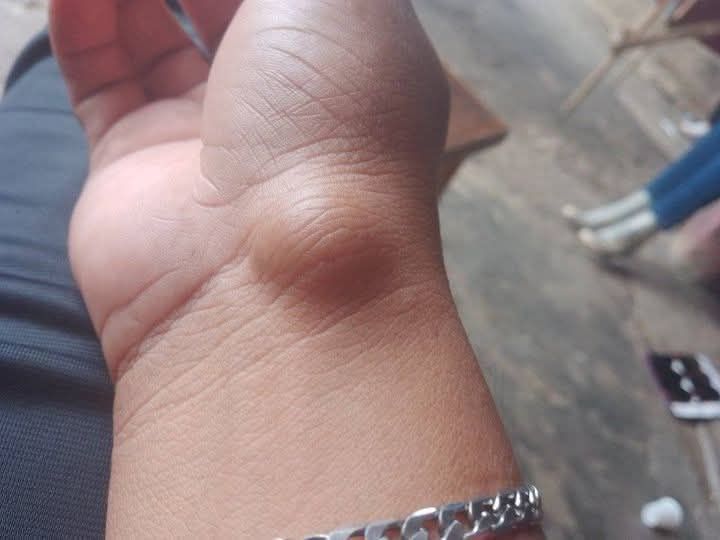ADVERTISEMENT
### **3. Arthritis: Osteoarthritis or Rheumatoid Arthritis**
Arthritis, particularly **osteoarthritis** and **rheumatoid arthritis**, can also cause lumps or swelling in the joints of the hand. In osteoarthritis, the protective cartilage in the joints breaks down over time, leading to pain, swelling, and sometimes lumps. Rheumatoid arthritis is an autoimmune disease that causes inflammation in the joints, which can also result in lumps, often at the base of the fingers.
#### **Symptoms of Arthritis:**
– Pain or tenderness in the joints of the hand, especially with movement
– Stiffness, especially after rest
– Swelling, often accompanied by visible lumps
– Decreased range of motion in the fingers or wrists
#### **Remedies and Treatment:**
– **Anti-Inflammatory Medications:** NSAIDs or corticosteroids can help reduce inflammation and pain.
– **Physical Therapy:** A physical therapist can teach exercises that improve joint mobility, flexibility, and strength.
– **Hand Splints:** Wearing splints can stabilize the affected joints and reduce strain.
– **Heat and Cold Therapy:** Applying heat to the area may help relax stiff joints, while ice can reduce swelling and pain.
– **Surgical Intervention:** In severe cases, surgical procedures such as joint replacement or synovectomy may be necessary to address joint damage.
—
### **4. Trigger Finger (Stenosing Tenosynovitis)**
**Trigger finger** is a condition that affects the tendons in the fingers, causing them to become swollen or thickened. This can lead to a lump or nodule near the base of the finger, along with difficulty straightening the finger or a sensation of it “locking” or catching.
#### **Symptoms of Trigger Finger:**
– A lump or nodule at the base of the finger
– Pain or discomfort, especially when trying to straighten or bend the finger
– A sensation of the finger locking or catching in one position
#### **Remedies and Treatment:**
– **Rest and Avoiding Aggravating Activities:** Giving the finger time to heal by avoiding repetitive tasks can help.
– **Splinting:** Wearing a splint may help keep the finger in a neutral position and prevent further irritation.
– **Stretching and Range of Motion Exercises:** Once the inflammation subsides, gentle stretching exercises can help improve flexibility in the affected finger.
– **Steroid Injections:** Corticosteroid injections are commonly used to reduce inflammation and relieve symptoms.
– **Surgery:** If conservative treatments don’t help, surgery may be required to release the tendon sheath and allow for proper tendon movement.
—
### **5. Lipomas or Benign Tumors**
A **lipoma** is a non-cancerous fatty lump that can form beneath the skin, often appearing as a soft, movable lump. While they are typically harmless, they can cause discomfort if they press on surrounding tissues or nerves.
#### **Symptoms of Lipomas:**
– A soft, rubbery lump beneath the skin
– The lump is usually painless, but it can cause discomfort if it grows large or presses on nerves
– The lump is often slow-growing and may vary in size
#### **Remedies and Treatment:**
– **Observation:** If the lipoma is small and not causing discomfort, it may simply be monitored over time.
– **Surgical Removal:** If the lipoma is large, causing pain, or growing rapidly, a healthcare provider may recommend removing it surgically.
– **Steroid Injections:** In some cases, steroid injections can help shrink the lipoma.
—
## **When Should You See a Doctor?**
While many conditions that cause a “ball” or lump in the hand can be managed with self-care, there are times when you should seek professional medical help. You should consult a healthcare provider if:
– The lump or swelling is persistent or growing in size.
– The lump is painful or causes significant discomfort.
– You experience difficulty moving your hand or fingers.
– There are signs of infection, such as redness, warmth, or drainage from the lump.
– You have a history of cancer or other serious health conditions.
A doctor will be able to perform a thorough examination, possibly using imaging tests (such as X-rays or ultrasound), to identify the underlying cause of the lump and recommend an appropriate course of treatment.
—
## **Conclusion**
A “ball” or lump in your hand can result from a variety of conditions, ranging from benign issues like ganglion cysts and lipomas to more complex problems such as tendonitis or arthritis. The good news is that many of these conditions can be managed effectively with rest, physical therapy, anti-inflammatory medications, or other treatments.
If the lump or swelling persists, causes significant pain, or affects your ability to use your hand, it’s important to seek professional care for an accurate diagnosis. Early intervention can help prevent further complications and ensure that you can return to normal activities with minimal discomfort.
Remember, taking good care of your hands and wrists, practicing proper ergonomics, and avoiding repetitive movements can go a long way in preventing some of these conditions. So, whether it’s a ganglion cyst or tendonitis, understanding the root cause and seeking appropriate treatment will help you find relief and improve your overall hand health.
